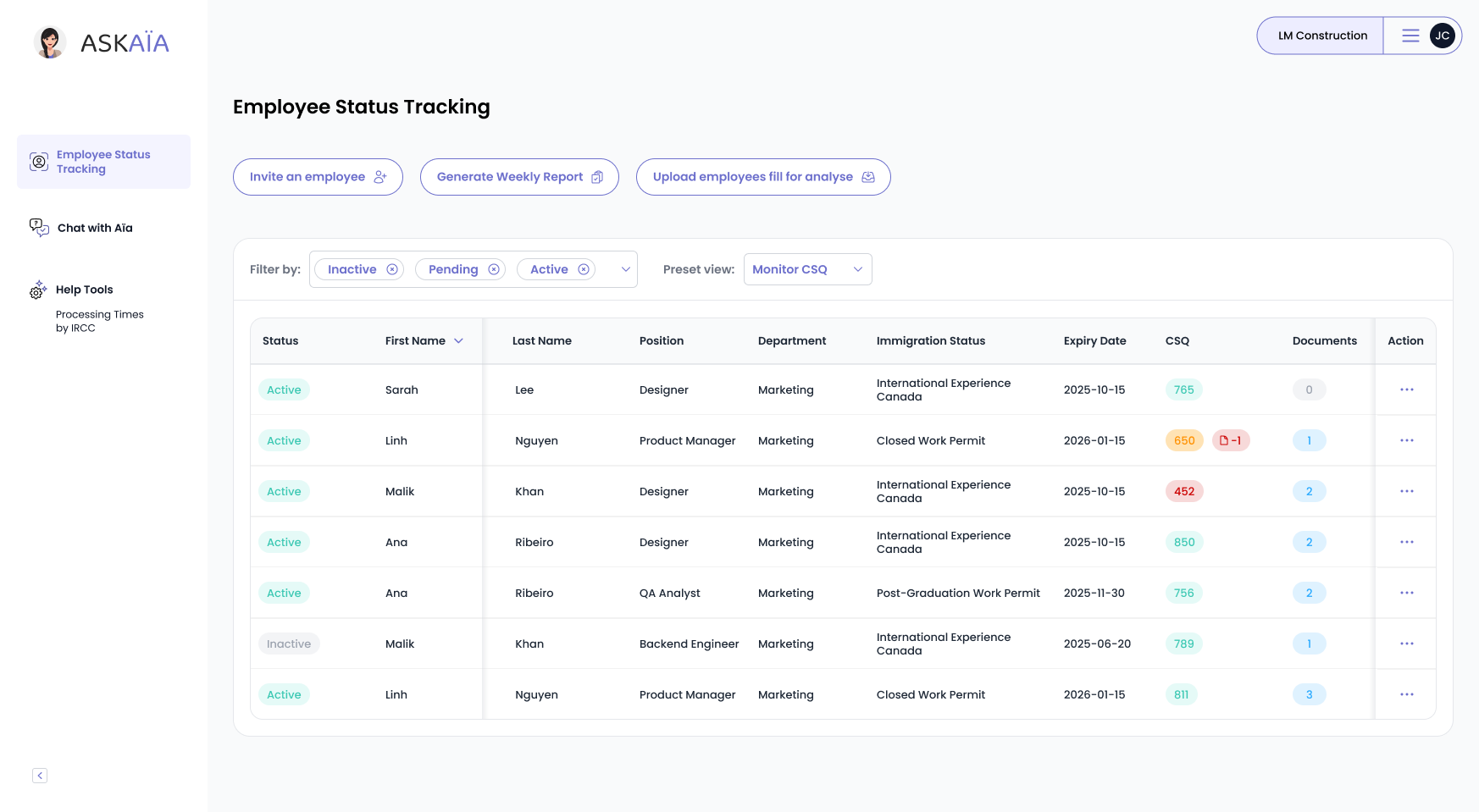For Canadian employers recruiting temporary foreign workers, the Labour Market Impact Assessment (LMIA) is a critical, and often unpredictable, step. With delays now extending beyond 12 weeks in some cases, failure to anticipate LMIA timelines can jeopardize operations, especially in industries with seasonal or high-turnover roles.
This article outlines LMIA-related fees, current processing times from official sources, and how HR teams can build effective hiring calendars. Whether you're an employer planning ahead or a worker relying on LMIA-backed offers, understanding these timelines is essential to avoid costly disruptions.
What Causes LMIA Delays and Why They Matter
- High-wage stream: 11 weeks
- Low-wage stream: 13 weeks
- Seasonal Agricultural Worker Program: 9 weeks
- Global Talent Stream (GTS): 10 business days (usually respected)
However, these averages only account for Service Canada's file handling. Employers must also complete:
- A minimum 4-week recruitment period with job postings on 3 platforms
- Document preparation and submission, often taking 1–3 weeks
- Potential reassessment or requests for additional documentation
Example: A Quebec-based food packaging company applied for a low-wage LMIA in March 2024. After completing their recruitment and submitting in April, they received a decision in mid-July, a total of 14 weeks post-submission and nearly 20 weeks from start to finish.
Delays affect not just hiring, but immigration too. Many foreign workers can’t apply for a work permit until a positive LMIA is issued. This ripple effect impacts onboarding, training, and even PR timelines under programs like Express Entry and the Quebec Skilled Worker Program.
Fees and Timelines: What Employers and Workers Should Expect to Pay and Plan For
Each LMIA application costs $1,000 CAD per position, as stated by Employment and Social Development Canada (ESDC). This fee:
- Is paid by the employer
- Cannot be recovered from the worker
- Is non-refundable, even if the LMIA is denied or withdrawn
Exemptions: Employers hiring under certain programs (e.g., agriculture, caregivers, or positions under international agreements) may be exempt from the fee.
Beyond fees, employers must factor in the cost of time:
| Step | Estimated Time |
| Recruitment advertising | 4–6 weeks |
| Document preparation | 1–3 weeks |
| ESDC processing | 9–13 weeks |
| Work permit application (after LMIA) | 4–8 weeks |
Total Estimated Timeline: 16–24 weeks
That’s up to 6 months between launching recruitment and onboarding a worker.
For Workers:
For foreign workers relying on LMIA-backed offers, these delays can cause major uncertainty. Permit applications can’t begin without a valid LMIA, meaning employment start dates, and immigration status, may be pushed back unexpectedly.
Fastest LMIA Streams (2025)
Some streams still operate efficiently, especially with priority processing:
- Global Talent Stream: 10 business days
- Seasonal Agricultural Worker Program: 9 weeks
- Francophone Mobility (LMIA-exempt): Often completed in under 4 weeks
HR Calendars: Why You Need a 6-Month Hiring Window
Given current realities, HR departments must rethink recruitment cycles. Planning only 2–3 months ahead is no longer viable.
Backward Planning Example:
An employer needs a worker to start on October 1, 2025.
They should begin recruitment by:
- April 15: Begin recruitment campaign
- May 15: Submit LMIA application
- August 15–September 1: Receive decision
- September 1–October 1: Submit work permit and allow for arrival
Ideal HR planning window: At least 5–6 months
This kind of foresight is especially critical in:
- Agriculture: Planting/harvest seasons are fixed. LMIA delays can ruin entire crop cycles.
- Hospitality: Hotels in Alberta or B.C. must plan summer and winter staffing far in advance.
- Construction and trades: Delays mean projects risk missing deadlines or violating contracts.
Tip: Create an internal LMIA calendar tool with key deadlines. Add recruitment launch dates, expected LMIA outcomes, and buffer periods.
Avoiding Bottlenecks: Best Practices for Employers
To minimize risk and cost:
- Start Early. The earlier you post ads, the more time you allow for delays. Recruitment should begin at least 4–5 months ahead of the desired start date.
- Use Accurate NOC Codes. Errors in job descriptions or codes are a common reason for LMIA rejections. Double-check NOC 2021 classifications.
- Track Application Statuses Closely. Ensure follow-ups on any ESDC requests are timely and complete. Keep organized records of all communications.
- Consult Professionals. Consider using an RCIC (Regulated Canadian Immigration Consultant) to avoid delays due to paperwork errors. You can book a free consultation with us.
Explore Alternatives:
Some roles may qualify for LMIA-exempt pathways, like:
- International Mobility Program (IMP), includes youth exchanges, intra-company transfers
- Francophone mobility stream, faster processing for French-speaking foreign workers outside Quebec
By anticipating LMIA delays and structuring your recruitment around realistic timelines, both employers and foreign workers can avoid disruptions, reduce stress, and improve the success of hiring plans in 2025.
Don’t wait until submission day to organize your file. Book a free consultation with our team to plan your next hire.

Let’s get your demo started
Book a demo
You May Also Like
These Related Stories

LMIA: Can you get a work permit? All Your Questions Answered
Many newcomers struggle with securing a job in Canada due to Labour Market Impact Assessment (LMIA) complexities. Who qualifies? How do you apply? Wha …

LMIA File Prep 2025: Documents, Proof & Transition Plans Explained
Posting the job is only half the LMIA battle. For HR teams, most rejections happen when the file is incomplete: missing documents, vague transition pl …

Get Canada PR: Express Entry Steps Explained by a Consultant
Express Entry is Canada’s fastest route to permanent residency, but the rules can be confusing. If you’re a skilled worker or international graduate, …


